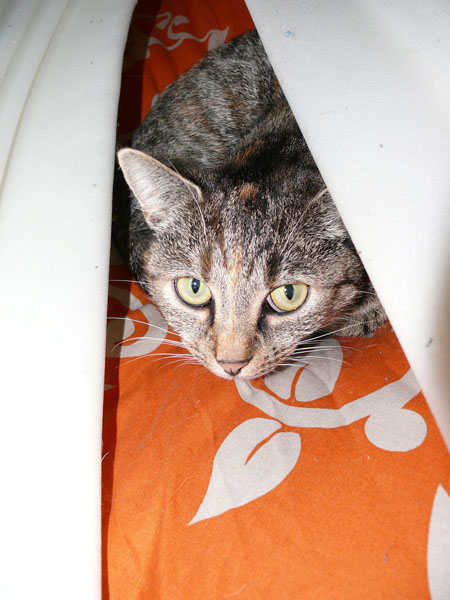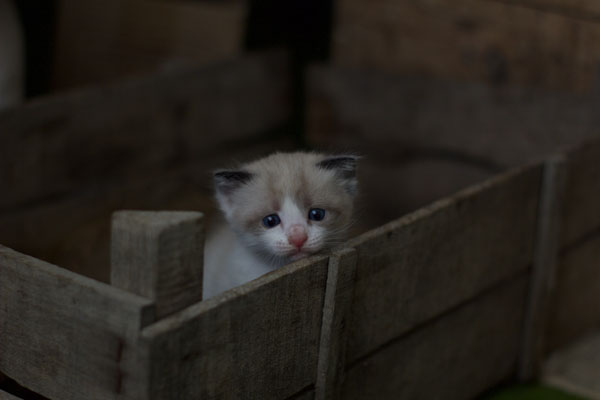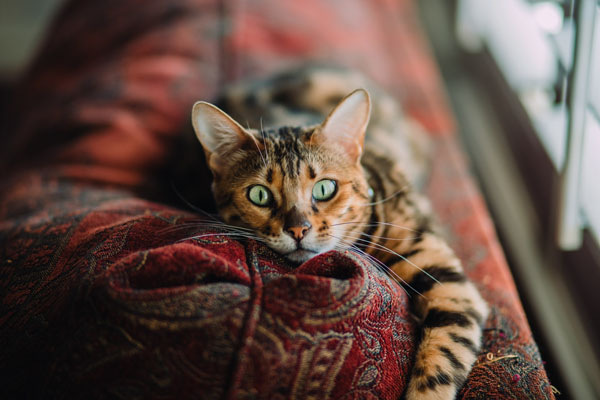Cats are one of the most stoic creatures you’ll encounter. As they look at you, there’s no telling what they’re thinking. It’s one of the reasons we love them. So much goes on behind that feline smile. Unfortunately, a cat’s desire to hide isn’t always in their best interest. They often hide when they’re feeling sick. We don’t realize there’s a problem until the last minute (when they CAN’T hide anymore). They’ll even disguise physical injuries as much as possible. And when you have a stressed cat? You can easily miss the warning signs. Before you know it, you have a cat that’s tucked into a corner under the bed, refusing to eat. There ARE clues that stressed cats give off, though. We’re going to explain the most common causes of stress in felines – and what you can do to prevent it.
Stress
No one likes stress. It tightens that spot between your shoulders you can’t reach, gives you migraines, and makes your stomach sour. And while no one knows if animals feel the same way, we DO know they experience stress. Stress results from the sympathetic nervous system, influenced by the HPA axis (the hypothalamus, pituitary gland, and adrenal glands). Together, these systems produce natural hormones and cortisol that result in the body’s “fight or flight” response. It’s what keeps a body alive. And it’s also considered an acute (short-term) stress response.
Acute Stress
Odds are, your cat isn’t battling other predators daily. However, they still need that acute stress response in their lives. (So do you) If something starts to fall towards them, the sympathetic nervous system kicks in to get their body moving OUT of the path. It sounds strange, but it’s a healthy dose of stress. All of us evolved to cope with that kind of stress.
Now, you don’t want your poor cat to ALWAYS feel like they’re struggling through an obstacle course. Outdoor cats cope with more acute stress than indoor cats. There are more hazards present:
- Other animals
- Traffic
- Fences and other barriers
- Nature itself
- Strangers
Chronic Stress
Stressed cats come from chronic (long-term) stress. And that’s the kind the body doesn’t know how to handle. When excess cortisol levels build up, the body remains in that “fight or flight” mode. It’s on edge ALL the time, trying to figure out where the threat’s coming from. If your cat finds numerous sources of acute stress piling up, they go into chronic stress mode. And this is where you start to notice the biggest problems.
Incidentally, chronic stress is also the biggest problem in HUMANS.

Signs of a Stressed Cat
How do you know you have a stressed cat on your hands? It IS tricky. Cats don’t like to show weakness. So even though they feel like the world is collapsing on their heads, they put on a brave face. You’ll need to keep a close eye on behavior changes to catch these important signs.
In a moment of ACUTE stress, you’ll see a noticeably stressed cat. They make themselves SMALL. They crouch down on the ground to hide their vulnerable belly and tuck their tail in tight. The ears and whiskers all pin back tight to the head. Their pupils go WIDE to catch all the available light. And you’ll hear an UPSET cry. They may shake or even involuntarily lose their bladder or bowels. It’s easy to spot. But it’s also QUICK. (Remember, this is acute stress when the body’s preparing for FAST action)
Chronic stress is a different story. Those signs focus more on behavior:
- Lack of interest in food, energy, or play
- Inappropriate elimination
- Urine spraying
- Excessive grooming – sometimes leaving their legs and belly completely BALD
- Hiding
- Demanding excessive attention
- Aggression
- Obsessive-compulsive behaviors
- Hypervigilance
The body is so keyed up, your cat is desperate for SOMETHING to do. How they react depends on their personality, but they usually WON’T act like themselves. That’s your first clue that something’s wrong.
Causes of a Stressed Cat
Cats are creatures of habit. Anything new or different has the potential to create stress. And their usual stoic nature means we often overlook their love of routine. Those stressed cat signs pop up, and we’re left scrambling to remember what we did differently. Good thing you can break down the most common causes of stress. It’ll help you retrace your steps to find the root of the problem.
Causes of a Stressed Cat: Roommates
A lot of stressed cats result from multi-cat households. As competition over the resources in the house escalates, so does the strain on the relationships. Everyone may have gotten along when they were kittens, but now that they’ve reached adult size, the territory feels small and confined. You may not realize there’s one cat bullying and hogging the food bowls or litter boxes. Meanwhile, your stressed cat feels they can’t use the bathroom or only gets a couple of kibbles a day.
You can’t make your house larger. And that means there may not be enough room for everyone to feel like a master of their own domain. Cats are territorial by nature. If everyone doesn’t get their own “piece of the pie,” they’ll start to feel uncomfortable. In 1997, a study found that a quarter of cats shared food bowls, while HALF needed to share litter boxes. It impacts behavior BIG TIME.
Causes of a Stressed Cat: People
If you’re stressing about anything (work, home, relationships, the car), so will your cat. Animals pick up on our emotional state. So your poor stressed cat could feel that way due to the endless stress YOU’RE feeling! (Which isn’t healthy for you, by the way)
As people come in and leave the house, you shake up the normal dynamic for the resident feline. They’re not wild about new additions to the family. You want to introduce significant others, but does your cat approve? (My husband was scared to death when I told him our relationship hinged on whether or not the cats liked him) It’s rough on your felines for people to come in and disturb everything.
And it’s every bit as stressful for people to LEAVE. They’ll search around for that individual, trying to figure out where they went. Change is change, whether it comes in the form of people or household routine.
Not to mention strangers. A 2016 study found strangers to be the biggest impact of stress in cats!

Causes of a Stressed Cat: Behavior
Did you rescue your cat? Do you know their history? Kittens that don’t receive proper socialization – where they’re exposed to novel people and situations – often end up as stressed cats. They have no reference for different experiences, which means their bodies are in a constant state of acute stress. They need that crucial period to see new toys, meet different people, and hear as many sounds as possible.
Cats that are rehomed time after time develop separation anxiety. This makes a trip in the car or going to the vet traumatic. They have memories of being unwanted and going to a shelter over and over. So even though YOU have never done so, the stress goes high each time you make a simple trip. My parents’ oldest cat was rehomed four times. So when we take her to the vet, she exhibits every sign of acute stress, no matter how much we soothe her and assure her it’s okay. And my parents have had her for ELEVEN years. It’s heart-breaking every year.
And, unfortunately, as cats move into their senior years, feline dementia sets in. They start to get problems with memory. They can also develop joint pain. Higher litter box sides may become difficult to navigate, to say nothing of climbing on cat trees or furniture. The struggles cause their anxiety to climb.
Causes of a Stressed Cat: Household
Maybe that change in your work schedule is better for you. And you’re delighted to get a newly remodeled kitchen (you saved up for years). But what do those changes do to your cat’s world?
You can set up automatic feeders and water bowls for your cat to make sure they don’t miss a meal. But is your cat used to you scooping the food for them? It’s a slight change, but the impact on their life is HUGE. They may not want to adapt.
And the noise from renovations always produces stressed cats. Not only are strangers invading the home, but it sounds like the place is coming down around their heads. It’s exciting for you and traumatic for them. My parents redid one of their bathrooms. A few days into the work, they noticed one of their cats missing. TWO WEEKS later, they found her – under the house. The poor thing snuck past everyone and darted into the crawlspace; she was so frightened. (She was okay, in case you wonder. A little thinner, but otherwise okay)
Helping Your Stressed Cat
Okay, so you’ve identified that you have a stressed cat. You may have also zeroed in on the trigger. Now what?
First, you need to take your poor anxious feline to the vet. Why? Because those stressed cat symptoms may be signaling an underlying health condition. Since you’re dealing with the pituitary and adrenal glands, there’s a possibility they’re not functioning properly. Get a clean bill of health FIRST.
You may need to discuss the possibility of anti-anxiety medications. (Yes, they make kitty-Xanax) The stress level is so high for some cats, and their behaviors are so dramatic that medication is needed. If your cat is BALD, you need to look at intervention to allow the hair to regrow. (Putting pajamas on your cat will only make the stress worse. Plus, they’ll start grooming the pajamas)

Counter-Conditioning
When you know you have a healthy cat, it’s time to move on to ease the stress. Counter-conditioning is a form of training that works beautifully with stressed cats. You need to know the source of your cat’s anxiety for it to work, though.
Say it’s your departure for work (i.e., separation anxiety). Slowly, you work on getting your cat to settle somewhere comfortable. They get a treat or their favorite toy each time. It’s replacing the stress (you leaving) with something positive (the treat).
We’ve been doing counter-conditioning with my parents’ cat for vet trips. They leave the carrier out for days before the vet visit. If she goes anywhere near it, she gets treats. She also gets treats in the car the entire ride. It’s helping, though we have a ways to go. (It probably doesn’t help that she only has to go once a year)
Home Front
Honestly, most of the work happens around the house. You know what the problem is, so you have a pretty good idea of how to fix it.
- Multi-Cat Households: Follow the “plus one” rule. For every cat in the house, you need enough food bowls and litter boxes for everyone to have their own, plus one extra. Space them out throughout the house, so no one has to feel cornered. Use plenty of scratching posts, in different textures, at different heights, and in different materials. This way, EVERYONE has their own space. Catification does wonders for making the most of your home’s space.
- Noise: If you have a renovation planned, set up a quiet room for your cat as far from the work as possible. Do the same when you’re bringing strangers over. Set up their food, litter box, and toys so they feel comfortable.
- Attention: Cats need something to distract from boredom when you’re not around. Electronic cat toys are great options. And when you’re home, set aside time for your felines to snuggle.
- Behavior: You CAN work with a cat trainer if you need help. There’s no shame in asking for help.
Kitty Therapy
Stress isn’t healthy – for anyone. And the fact that stressed cats like to hide their symptoms doesn’t help. You need to keep a close eye out for subtle shifts in behavior. If you know you’re going to change something in the household, try to do so as gradually as possible to give your resident feline a chance to adapt. Cats don’t like change. If they can think through the adjustment, they’ll accept it a little better.
Then you won’t have to worry about hunting down a cat psychologist. (I’m kidding)













No comment yet, add your voice below!